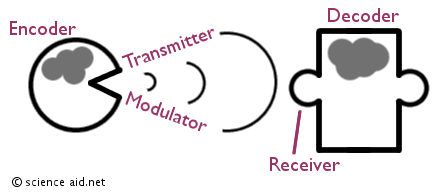Communication Systems: Composition, Transmitting and Receiving, Storage on Computer Disks
Edited by Jamie (ScienceAid Editor), Taylor (ScienceAid Editor)
Composition of Communication Systems
Communication systems can be broken down in to several components, each with its own specific function. The table below explains these key components and what they do.
| Encoder | Converts information to a form that can be sent. |
| Modulator | Varies the wave carrying the signal. |
| Decoder | Translates information to a form that can be understood. |
| Storage | Where information is held. |
| Transmitter | Sends signals from one place to another. |
| Receiver | Picks up the signal that has been sent to it. |
| Transducer | Changes signal from one form to another. |
| Amplifier | Increases the amplitude of a signal. |
The diagram below demonstrates a system by example of speech.
Transmitting and Receiving
A common method of transmission is fibre optic cables. They are simply wires that carry light. They are used for internet transmission and there are huge networks of fibre optics on the ocean floor. The signal along these is digital. A digital signal is either 'on' or 'off' compared to an analogue signal which has a variety of different values.
Signal quality can be reduced in transmission by attenuation where the signal becomes weaker with distance by losing energy. Or noise where the amplitude is distorted.
Because of attenuation, the signal must be amplified by repeaters, but in an analogue signal this means the noise is also amplified and hence the resultant signal received is of poorer quality. Because of the simplicity of a digital signal, it can undergo regeneration to it's original form. It is for this reason that digital signals are seen as better than analogue.
Storage: Computer Disks
As explained above, digital information is either 'on' or 'off' and so could be represented as either 1 or 0. This forms the basis of binary code that is used as the basis for computing.
A CD has a series of bumps on it that represent 1 or 0, these are read using light. See the diagram below.
The diode laser emits a small beam of concentrated light (laser beam) onto the disk surface. This is then reflected back and can be detected by the photodiode by a change in the intensity of the light reflected. This is why if there is a scratch on your CD surface it will interfere with the quality.
Referencing this Article
If you need to reference this article in your work, you can copy-paste the following depending on your required format:
APA (American Psychological Association)
Communication Systems: Composition, Transmitting and Receiving, Storage on Computer Disks. (2017). In ScienceAid. Retrieved Apr 25, 2024, from https://scienceaid.net/physics/waves/communication.html
MLA (Modern Language Association) "Communication Systems: Composition, Transmitting and Receiving, Storage on Computer Disks." ScienceAid, scienceaid.net/physics/waves/communication.html Accessed 25 Apr 2024.
Chicago / Turabian ScienceAid.net. "Communication Systems: Composition, Transmitting and Receiving, Storage on Computer Disks." Accessed Apr 25, 2024. https://scienceaid.net/physics/waves/communication.html.
If you have problems with any of the steps in this article, please ask a question for more help, or post in the comments section below.
Comments
Article Info
Categories : Waves
Recent edits by: Jamie (ScienceAid Editor)










